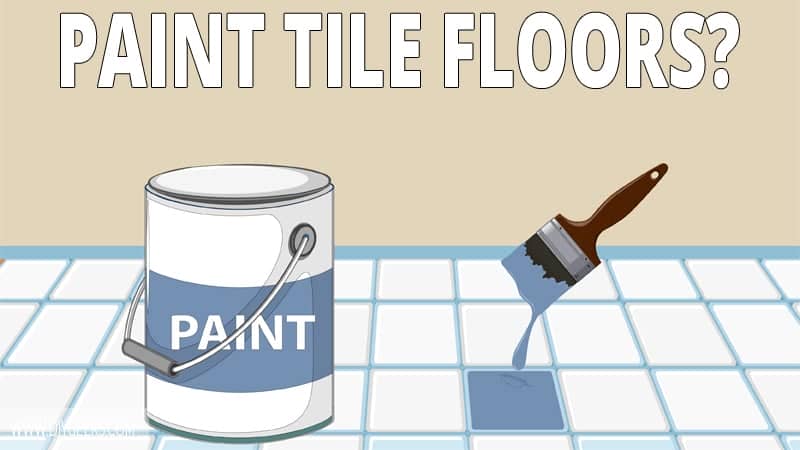You can paint tile floors with floor paint if you sand and remove the floor protective coating first. The new paint will create a unique color shade over the floor.
To paint tile floors, clean the floor, sand the floor, repair damaged tiles, and apply the paint.
Paint will improve the look of the floor, but it will also make stains and dirt more visible on the floor. Also, once you clean and sand off the original finish of the floor, you won’t be able to get an original look at the same floor again.
Should You Paint Tile Floors? (Pros/Cons)
The pros and cons of painting tile floors are listed below.
Pros
- Adds Beauty To The Home: Painting the tile floor will add beauty and class to the home.
- Revives Old Tiles: A paint coating can revive the tile floors and make them look better if they are old, stained, or faded.
- Protects the Floor: Exterior or waterproof paint can protect the floor from moisture, water, chipping, and scratches.
- Affordable: Painting tile floors is cheaper and more adorable than replacing them with new ones.
- Versatile: You can choose any paint color shade you want.
Cons
- Highlights Dirt on the Floor: A paint coating can highlight dust and dirt more than a normal floor finish. So, you need to clean the floors more often.
- You can’t Get a Natural Look: If you paint tiles, you can’t get the original color shade or look that it was before.
- Hard: Since the tile material is non-porous and sealed, you must sand and prep the properly before applying the paint.
Does Paint Adhere to Tiles?
Paint doesn’t adhere directly over tiles unless you sand and prep them properly. The tile material is non-porous and sealed with a protective coating, so its surface repels moisture, water, and all liquids.
Since the paint can’t penetrate the tile floor surface, it won’t adhere and will turn sticky. You must sand the tile floors to remove their protective coating and create tiny pores (holes) that the paint can penetrate and adhere to.
Which Paint Types Can You Apply over Tiles?
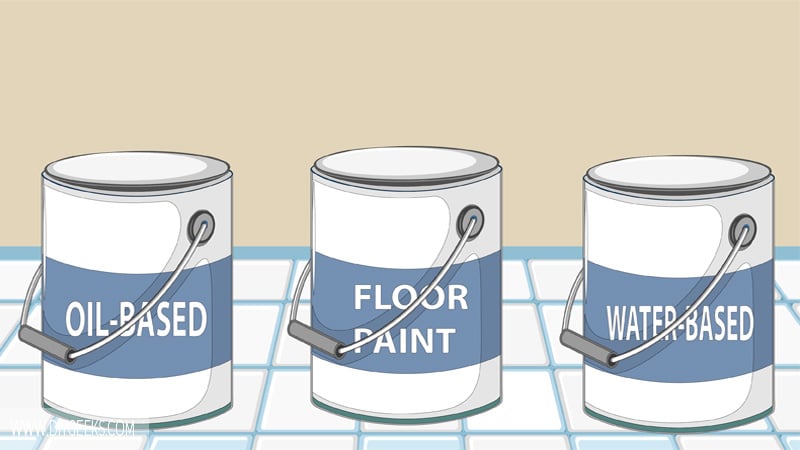
You can apply floor paint designed for tile floors as this paint is formulated with etching compounds that help it adhere over non-porous surfaces and create a moisture-resistant finish that protects the floor.
You can also use other paint types, but the results won’t be as good. For instance, you can use latex or acrylic paint, but they won’t adhere well nor protect the tiles from moisture. This is because latex paint can’t penetrate the floor, and it isn’t moisture-resistant.
How To Paint Tiles?
To paint tile floors, do the following things.
- Clean the floor.
- Sand the Floor.
- Repair Damaged Tiles.
- Apply the Paint.
The tools you need for this project are listed below.
- Floor Paint
- Tape
- Floor cleaner
- A mop
- Sprayer or roller
- Fine-grit sandpaper
- Orbital or floor sander
- A pair of gloves
- Paintable caulk
1. Clean The Floor
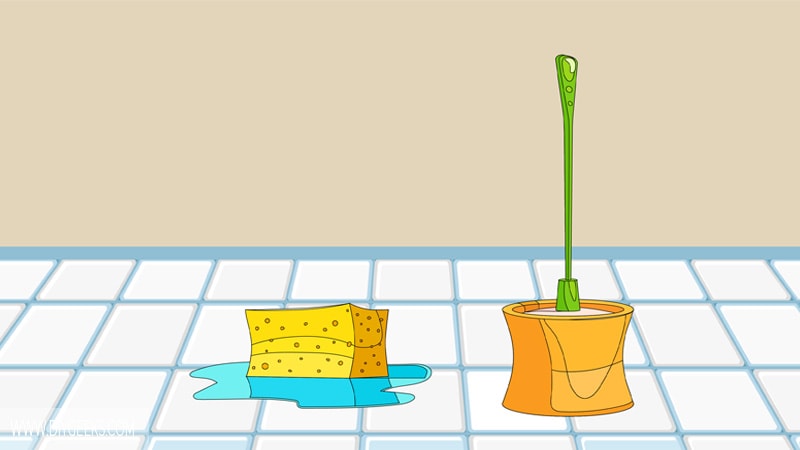
Clean the floor to remove dust, dirt, or debris that can clog the sandpaper and prevent it from removing the floor’s protective coating.
To clean the floor, do the following things.
- Sweep or vacuum the tiles to get rid of dirt and dust.
- Mix detergent with water, and use the mixture to wipe the entire floor.
- For stubborn stains, apply floor cleaner or TSP (Trisodium phosphate)
- Wait a few minutes.
- Use a floor brush or sponge to scrub the stain off the floor.
- Use clean water to remove the detergent or cleaner residue.
2. Sand The Floor
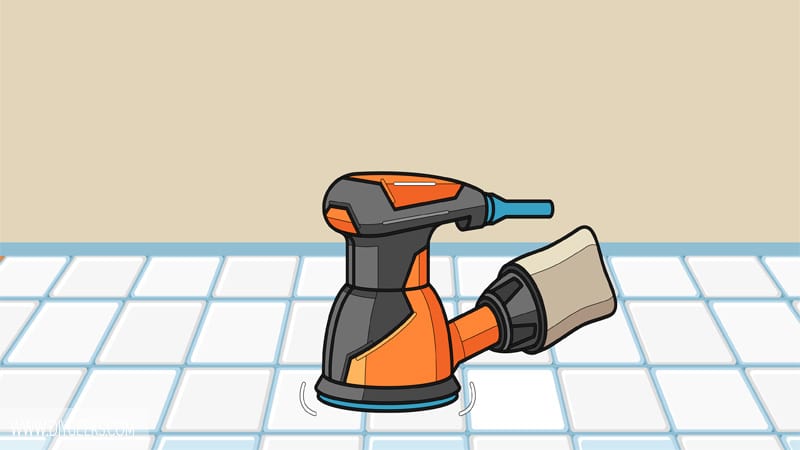
Sand the tiled floor with medium-grit sandpaper (100-grit) attached to a floor sander or orbital sander. The power sander removes the floor’s protective coating and creates tiny pores (or holes) on the surface that the paint can penetrate and adhere to.
3. Repair Damaged Tiles
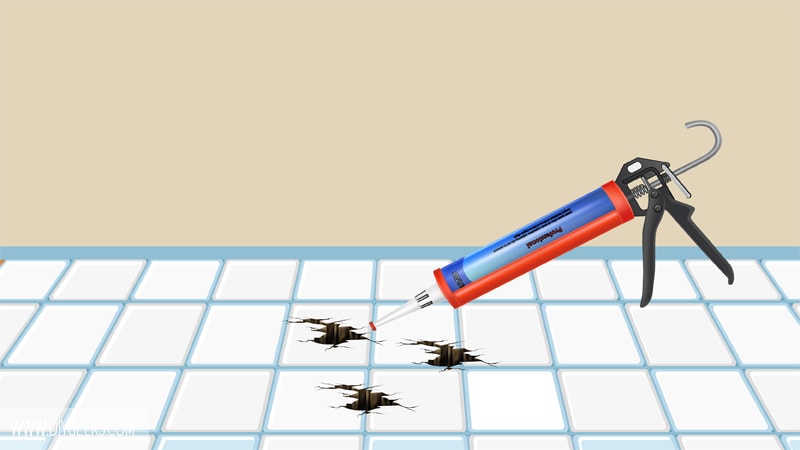
If the tile floor is damaged, repair (or fix) them with latex or acrylic caulk before applying the paint. If you don’t repair the damaged spot, the paint will soak into the holes (or cracks), and create an uneven finish.
To fix tiled floor cracks and dents, do the following things.
- Use latex or acrylic latex caulk.
- Fill the cracks with the caulk.
- Wait for the caulk to dry.
- Remove excess caulk by sanding or using a clean rag.
Cover the base walls with painter’s tape. This prevents the paint from splashing on the walls. If you want to use different colors or designs, use painter’s tape to demarcate the floor to know where to paint and where to stop.
4. Apply the Paint
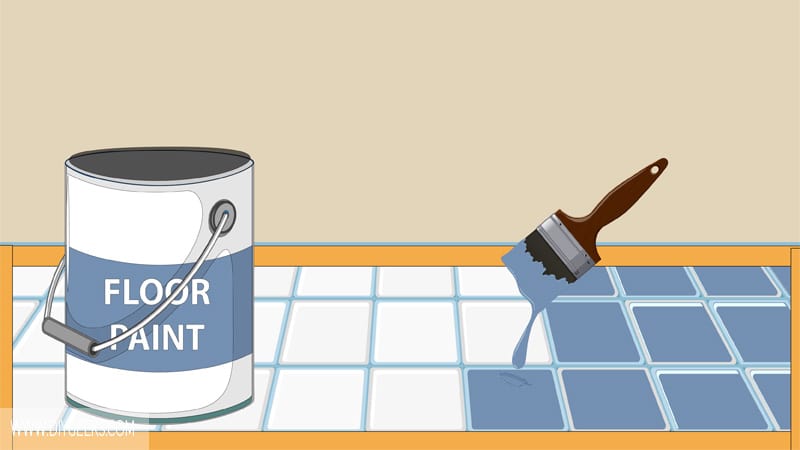
To paint ceramic tile floors, use a paint roller or sprayer to apply 2 coats of tile paint. Wait until the first coat dries before applying the second one. Optionally, you can seal the finish with polyurethane.
You don’t have to paint the floor grout. You just need to focus on painting the tiles first. Then if you decide to paint the grout, you can use a grout pen or grout paint to make the entire floor neater.
How Long Does Paint Last Over Tiled Floors?
Sealed floor paint lasts between 5-7 years over a tiled floor. Unsealed regular paint doesn’t last more than one (1) year over tiled floors, while sealed regular paint lasts between 3-5 years before you need to re-seal it.
Floor paint lasts more than regular paint as it’s formulated with more protective additives that create a more durable and moisture-resistant finish.
The exact time a paint will last over a tiled floor is determined by the room type and maintenance. For instance, paint lasts longer over a bedroom tiled floor than a bathroom floor.
Can You Change the Color of the Tiled Flooring?
You can change the color of tiled flooring by painting it with a different shade or color of paint. However, you must remove the existing paint from the floor before applying another paint. This is because applying multiple coats of paint will lead to weak adhesion between the paint and the ceramic tiles.
Also, you can change the color of the floor by whitewashing or bleaching it. But, this only lightens the shade of the existing color. Applying polyurethane will also lighten the color, since it’s a clear coat the finish will appear lighter than it is.
